 W
WA tile is a thin object usually square or rectangular in shape. A tile is a manufactured piece of hard-wearing material such as ceramic, stone, metal, baked clay, or even glass, generally used for covering roofs, floors, walls, or other objects such as tabletops. Alternatively, tile can sometimes refer to similar units made from lightweight materials such as perlite, wood, and mineral wool, typically used for wall and ceiling applications. In another sense, a tile is a construction tile or similar object, such as rectangular counters used in playing games. The word is derived from the French word tuile, which is, in turn, from the Latin word tegula, meaning a roof tile composed of fired clay.
 W
WAzulejo is a form of Portuguese and Spanish painted tin-glazed ceramic tilework. Azulejos are found on the interior and exterior of churches, palaces, ordinary houses, schools, and nowadays, restaurants, bars and even railways or subway stations. They are an ornamental art form, but also had a specific functional capacity like temperature control in homes.
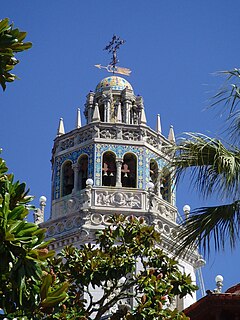 W
WCalifornia Faience was a pottery studio in Berkeley, California in existence from 1915 to 1959. It produced tiles, decorative vases, bowls, jars and trivets. It was run by William V. Bragdon and Chauncey R. Thomas who also taught at the California School of Arts and Crafts in Oakland, California. The name refers to a pottery style and technique: faience.
 W
WCatalina Pottery is the commonly used name for Catalina Clay Products, a division of the Santa Catalina Island Company, which produced brick, tile, tableware and decorative pottery on Santa Catalina Island, California. Catalina Clay Products was founded in 1927. Gladding, McBean & Co. acquired all of the assets of the company in 1937 and moved all production to its Franciscan dinnerware division in Los Angeles.
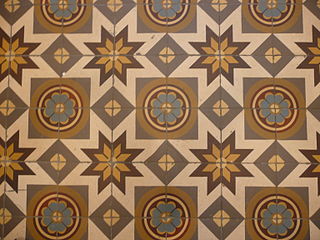 W
WCement tiles or hydraulic tiles are handmade colourful tiles used as floor and wall tiling. They appeared in Catalonia (Spain) in the 1850s, and have been widely used in Europe and America. They represented a revolution in flooring in their day because they were much cheaper, more durable and easier to make than the previous handmade glazed ceramic tiles and were therefore more universally available for houses, and they allowed for profuse decorative patterns, their age of splendour being the end of the 19th to the middle of the 20th centuries, before they were gradually superseded by newer technology as of the 1960s, such as terrazzo, salt-glazed stoneware, etc. that didn't allow for such decorative embellishment but were cheaper.
 W
WCuerda seca is a technique used when applying coloured glazes to ceramic surfaces.
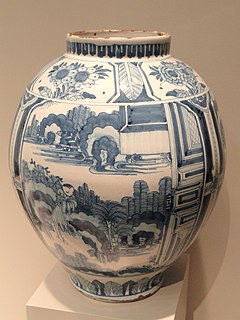 W
WDelftware or Delft pottery, also known as Delft Blue, is a general term now used for Dutch tin-glazed earthenware, a form of faience. Most of it is blue and white pottery, and the city of Delft in the Netherlands was the major centre of production, but the term covers wares with other colours, and made elsewhere. It is also used for similar pottery that it influenced made in England, but this should be called English delftware to avoid confusion.
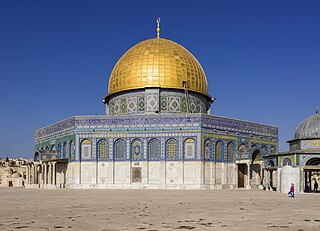 W
WThe Dome of the Rock is an Islamic shrine located on the Temple Mount in the Old City of Jerusalem. It was initially completed in 691–92 CE at the order of Umayyad Caliph Abd al-Malik during the Second Fitna on the site of the Second Jewish Temple, destroyed during the Roman Siege of Jerusalem in 70 CE. The original dome collapsed in 1015 and was rebuilt in 1022–23. The Dome of the Rock is in its core one of the oldest extant works of Islamic architecture.
 W
WEncaustic tiles are ceramic tiles in which the pattern or figure on the surface is not a product of the glaze but of different colors of clay. They are usually of two colours but a tile may be composed of as many as six. The pattern appears inlaid into the body of the tile, so that the design remains as the tile is worn down. Encaustic tiles may be glazed or unglazed and the inlay may be as shallow as 1⁄8 inch (3 mm), as is often the case with "printed" encaustic tile from the later medieval period, or as deep as a quarter inch.
 W
WGlass tiles are pieces of glass formed into consistent shapes.
 W
WGlazed architectural terra-cotta is a ceramic masonry building material used as a decorative skin. It has been popular in the United States from the late 19th century until the 1930s, and still one of the most common building materials found in U.S. urban environments. It is the glazed version of architectural terracotta; the material in both its glazed and unglazed versions is sturdy and relatively inexpensive, and can be molded into richly ornamented detail. Glazed terra-cotta played a significant role in architectural styles such as the Chicago School and Beaux-Arts architecture.
 W
WThe Ishtar Gate (Arabic: بوابة عشتار) was the eighth gate to the inner city of Babylon. It was constructed in about 575 BCE by order of King Nebuchadnezzar II on the north side of the city. It was part of a grand walled processional way leading into the city. The walls were finished in glazed bricks mostly in blue, with animals and deities in low relief at intervals, these also made up of bricks that are molded and colored differently.
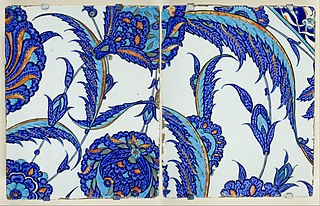 W
WIznik pottery, or Iznik ware, named after the town of İznik in western Anatolia where it was made, is a decorated ceramic that was produced from the last quarter of the 15th century until the end of the 17th century.
 W
WJackfield Tile Museum is a museum which presents the history of the British decorative tile industry between 1840 and 1960, the period in which this factory and that of Maw & Co nearby played an important part in this industry. The museum lies in the village of Jackfield, near Broseley, on the south bank of the River Severn in the Ironbridge Gorge, in Shropshire, England. It is located within a World Heritage Site, the birthplace of the Industrial Revolution. It is one of the ten Ironbridge Gorge museums administered by the Ironbridge Gorge Museum Trust.
 W
WJameh Mosque of Qazvin is one of the oldest mosques in Iran, and is the grand, congregational mosque of Qazvin, in Qazvin Province, Iran.
 W
WThe Jāmeh Mosque of Yazd is the grand, congregational mosque (Jāmeh) of Yazd city, within the Yazd Province of Iran. The mosque is depicted on the obverse of the Iranian 200 rials banknote.
 W
WMalibu Potteries was a ceramic tile manufacturer in Malibu, California. Malibu Potteries was founded by Rhoda May Knight Rindge in 1926. A fire devastated the company 30 September 1931, and the company closed in 1932. Tile designs included influences the styles of Moorish, Egyptian, Mayan and Saracen cultures. Many of the tile designs were geometric. The company was known for their tile murals consisting of tiles with peacocks and other birds. The company also produced decorated tiles for floors in the style of a laid-out Persian rug. May Rindge's daughter's house, the historic Adamson House, has many examples of the tile produced by Malibu Potteries.
 W
WMalibu tile is a type of ceramic tile that takes its inspiration from the tiles that were produced at Malibu Potteries in Malibu, California, during the latter half of the 1920s. These tiles reflect a style of design that is referred to as Hispano-Moresque or Arabesque exhibiting bright contrasting glaze colors often in geometric patterns that are reminiscent of tiles produced many centuries ago in the Near and Middle East, North Africa and southern Spain. The Adamson House in Malibu, California, now the Malibu Lagoon Museum, contains the largest and most varied display of Malibu Potteries tile. The Adamson House was added to the National Register of Historic Places in 1977 and became a California Historical Landmark in 1985.
 W
WMaw & Co have made earthenware encaustic tiles for walls and floors since 1850, when the English company was established by George Maw and his brother Arthur. Their first factory was in Worcester and in 1862 the company moved to Broseley, Shropshire in the Ironbridge Gorge. In 1883 they moved to the Benthall Works in Jackfield, Shropshire. The new, purpose-built factory was the largest tile works in the world and the company was the world's largest producer of ceramic tiles, making more than 20 million pieces a year.
 W
WMedieval letter tiles are one-letter ceramic tiles that were employed in monasteries and churches of the late Middle Ages for the creation of Christian inscriptions on floors and walls. They were created by pressing stamps bearing a reverse image into soft clay, which was then baked hard, and they were used to form words by assembling single-letter tiles in the desired order.
 W
WA mural is any piece of artwork painted or applied directly on a wall, ceiling or other permanent surfaces. A distinguishing characteristic of mural painting is that the architectural elements of the given space are harmoniously incorporated into the picture.
 W
WPorcelain tiles or ceramic tiles are porcelain or ceramic tiles commonly used to cover floors and walls, with a water absorption rate of less than 0.5 percent. The clay used to build porcelain tiles is generally denser. They can either be glazed or unglazed. Porcelain tiles are one type of vitrified tiles and are sometimes referred to as porcelain vitrified tiles.
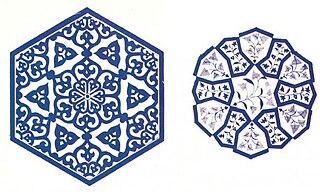 W
WQashani or Kashani is a Persian decorative arts which had been popular in Iran in the 16th to 18th century, and then moved to Turkey in the time of the Ottomans with the transfer of many Persians artists to Turkey, becoming the basis for decorating the walls of mosques, palaces, shrines and tombs. It is a square-shaped ceramic tile which uses Persian-like floral-depicting 4- or 6-sided glazed tiles, decorated with blue, cyan, green and sometimes red colors. The decoration is surrounded by fine black lines that make it stand out on its white floor. The tile work had often been decorated by the inscription, floral and geometrical patterns. The inscription often provides Qur'anic verses or sentences related to historical events written in Persian script. The plant often consists of natural flowers such as lily, cloves, roses and cypress trees. Geometrical patterns consists of different geometrical shapes and polygons. In Morocco, similar artistic technique is known as zillij. Its use has been widespread in the decoration of the walls of the buildings in the Ottoman era, and this mosaical feature can also be seen in the Dome of the Rock in Jerusalem. Kashi, the abbreviated form of Qashani, was also introduced to Sindh, Kutch, and Multan where numerous examples of shrines and mosques embellished with blue, white and green tile work exist.
 W
WRoof tiles are designed mainly to keep out rain, and are traditionally made from locally available materials such as terracotta or slate. Modern materials such as concrete and plastic are also used and some clay tiles have a waterproof glaze.
 W
WThe Shah Mosque is a mosque located in Isfahan, Iran. It is located on the south side of Naghsh-e Jahan Square. It was built during the Safavid dynasty under the order of Shah Abbas I of Persia. It was also known as the Imam Mosque after the Iranian Revolution.
 W
WIn the Netherlands, tegelspreuken are tiles inscribed with proverbs or aphorisms, often in blue-and-white Delftware style, used as decorative wall-hangings.
 W
WUranium tiles have been used in the ceramics industry for many centuries, as uranium oxide makes an excellent ceramic glaze, and is reasonably abundant. In addition to its medical usage, radium was used in the 1920s and 1930s for making watch, clock and aircraft dials. Because it takes approximately three metric tons of uranium to extract 1 gram of radium, prodigious quantities of uranium were mined to sustain this new industry. The uranium ore itself was considered a waste product and taking advantage of this newly abundant resource, the tile and pottery industry had a relatively inexpensive and abundant source of glazing material. Vibrant colors of orange, yellow, red, green, blue, black, mauve, etc. were produced, and some 25% of all houses and apartments constructed during that period used bathroom or kitchen tiles that had been glazed with uranium. These can now be detected by a Geiger counter that detects the beta radiation emitted by uranium's decay chain. In most situations, the radiation exposure is not excessive, but there may be exceptions for pure uranium oxide on bathroom floors, which can pose a hazard for infants crawling around.
 W
WVinyl composition tile (VCT) is a finished flooring material used primarily in commercial and institutional applications. Modern vinyl floor tiles and sheet flooring and versions of those products sold since the early 1980s are composed of colored polyvinyl chloride (PVC) chips formed into solid sheets of varying thicknesses by heat and pressure. Floor tiles are cut into modular shapes such 12" x 12" squares or 12" x 24" rectangles. In installation the floor tiles or sheet flooring are applied to a smooth, leveled sub-floor using a specially formulated vinyl adhesive or tile mastic that remains pliable. In commercial applications some tiles are typically waxed and buffed using special materials and equipment.
 W
WA tile is a thin object usually square or rectangular in shape. A tile is a manufactured piece of hard-wearing material such as ceramic, stone, metal, baked clay, or even glass, generally used for covering roofs, floors, walls, or other objects such as tabletops. Alternatively, tile can sometimes refer to similar units made from lightweight materials such as perlite, wood, and mineral wool, typically used for wall and ceiling applications. In another sense, a tile is a construction tile or similar object, such as rectangular counters used in playing games. The word is derived from the French word tuile, which is, in turn, from the Latin word tegula, meaning a roof tile composed of fired clay.
 W
WZellīj is a style of mosaic tilework made from individually hand-chiseled tile pieces set into a plaster base. The pieces were typically of different colours and fitted together to form elaborate geometric motifs, such as radiating star patterns. This form of Islamic art is one of the main characteristics of Moroccan architecture and medieval Moorish architecture. Zellij became a standard decorative element along lower walls, in fountains and pools, and for the paving of floors. It is found commonly in historic buildings throughout the region, as well as in modern buildings making use of traditional designs such as the Hassan II Mosque in Casablanca which adds a new color palette with traditional designs.